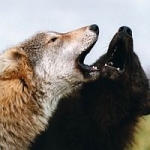 400 years ago Vermont was forested and wild. Among the familiar animals that roamed the region, wolves were in abundance, hunting in packs and howling at the moon.
400 years ago Vermont was forested and wild. Among the familiar animals that roamed the region, wolves were in abundance, hunting in packs and howling at the moon.
Many things changed when colonists arrived. And, for the wolf, the arrival of Europeans was the beginning of its demise. By 1900, over-hunting, trapping, poisoning, and loss of food and habitat drove wolves away.
This pattern repeated itself throughout the country, and in the 1970s wolf populations were found only on an island in Michigan and in Minnesota.
Since then, legal protections and reintroduction have saved the population from the brink and in many regions out west, wolf numbers have returned to healthy levels.
In Vermont, however, there has been no natural return of a sustainable population. Is there a chance the wolf could return naturally and survive in a changed landscape? Or, perhaps, should we think about deliberately reintroducing the species?
Kim Royar is a wildlife biologist with the Vermont Fish and Wildlife department. Michael Amaral is an endangered species biologist with U.S. Fish and Wildlife Service, based in Concord, NH. They talked with VPR’s Jane Lindholm about the history and future of wolves in our region.